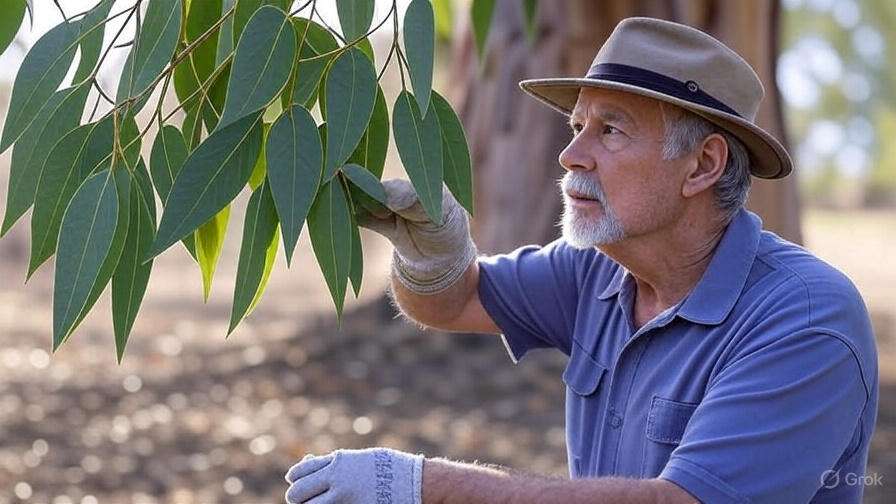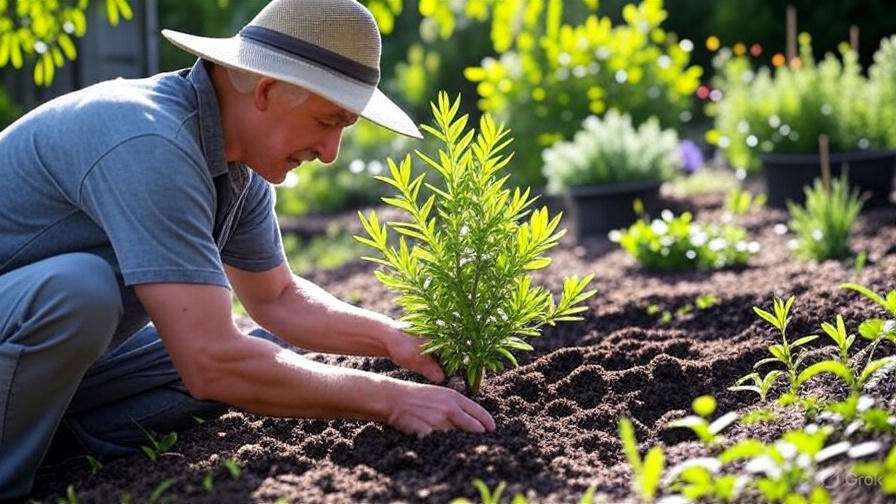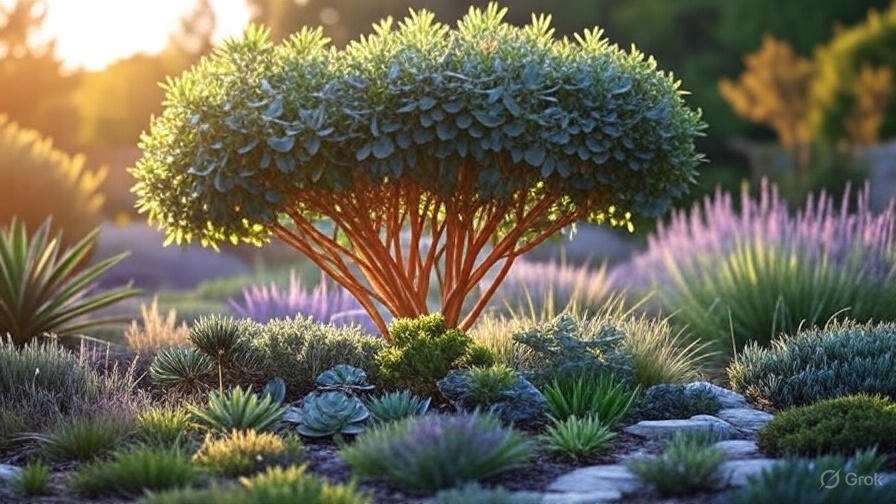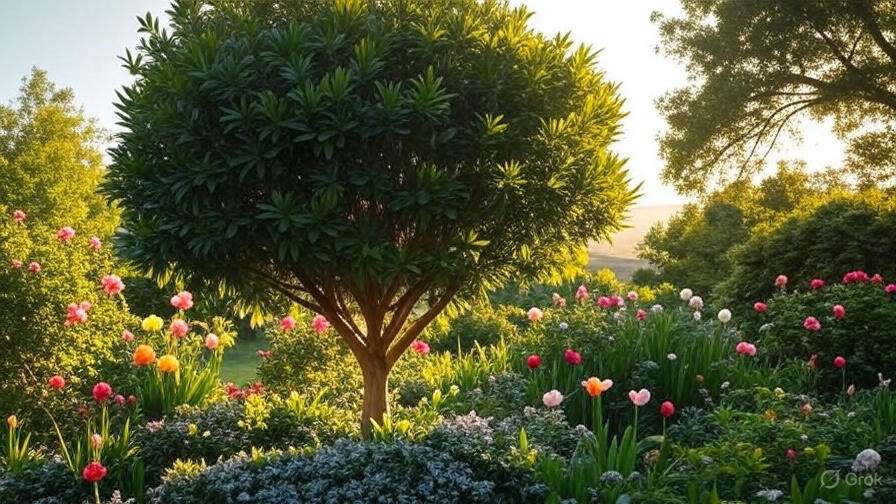
Tea Tree Eucalyptus: Benefits, Care Tips, and How to Grow It Successfully
Have you heard of the tea tree eucalyptus and wondered how this powerful plant could transform your garden or home? 

Table of Contents
ToggleWhat Is Tea Tree Eucalyptus? 
Tea Tree Eucalyptus, scientifically known as Eucalyptus camaldulensis, is a fast-growing, evergreen tree native to Australia. Known for its aromatic leaves and impressive height, it’s a beloved plant in gardens, herbal medicine, and essential oil production. But what exactly makes it stand out?
1. Distinctive Characteristics 
Tea Tree and Eucalyptus has narrow, lance-shaped leaves that release a refreshing, medicinal scent when crushed. The tree can grow up to 50 feet tall (15 meters) in ideal conditions and produces small, creamy-white flowers. Its bark is smooth and often peels off in patches, adding to its unique appearance.
2. Aromatic and Healing Qualities 
The oil extracted from its leaves has a range of health benefits, including antimicrobial and anti-inflammatory properties. Tea Tree and Eucalyptus oil is often used in aromatherapy to relieve respiratory issues and in skincare to treat acne or minor wounds. It’s not just a pretty tree—it’s a powerhouse of natural healing!
3. Where It Grows Best 
While Tea Tree and Eucalyptus is native to Australia, it thrives in warm, sunny climates. It prefers well-drained soil and can handle drought conditions once established. This makes it an excellent choice for gardeners in dry regions who want a low-maintenance tree that offers both beauty and utility.
4. Uses in the Garden and Beyond 
Beyond its medicinal uses, Tea Tree and Eucalyptus is also a favorite in landscaping for its striking appearance and fast growth. It’s commonly used as a screen or windbreak, thanks to its dense foliage. The tree’s leaves can also be harvested for homemade essential oils or added to garden mulch for a pleasant scent.
5. Key Benefits of Tea Tree Eucalyptus 
- Natural Air Purifier: Its leaves help purify the air, reducing pollutants and allergens.
- Wildlife-Friendly: The tree attracts native birds and insects, making it an excellent addition to a wildlife-friendly garden.
- Easy to Grow: Once established, Eucalyptus Tea Tree is relatively low-maintenance, requiring little water and minimal pruning.
Tea Tree and Eucalyptus is more than just a beautiful tree. It’s a multi-purpose plant that adds both aesthetic and practical value to your garden or home. Whether you’re looking for natural remedies, a fragrant landscape addition, or a tree with environmental benefits, this eucalyptus variety offers it all!

Benefits of Growing Tea Tree Eucalyptus 
Tea Tree Eucalyptus, also known as Eucalyptus alternifolia, is not only a stunning addition to your garden, but it also offers a variety of practical benefits. Whether you’re considering planting it for its beauty or its usefulness, here’s why you should add this versatile tree to your garden.
1. A Natural Air Purifier 
Tea Tree and Eucalyptus is known for its ability to purify the air. The tree releases a pleasant, refreshing aroma that helps reduce pollutants and improve air quality. Its leaves contain essential oils with antimicrobial properties, which can contribute to a cleaner, healthier environment around your home.
2. Aromatherapy Benefits 
The essential oil extracted from the leaves of Tea Tree and Eucalyptus is widely used in aromatherapy. It’s known for its calming and invigorating properties. Diffusing the oil can help reduce stress, improve mental clarity, and promote relaxation. Plus, the soothing aroma can freshen up your indoor spaces.
3. Repels Pests Naturally 
If you struggle with garden pests, Eucalyptus Tea Tree can help. Its strong, fragrant aroma naturally repels insects like mosquitoes, flies, and even certain rodents. You can plant it near your patio, garden, or doorways to keep unwanted critters away, making it a great natural alternative to chemical repellents.
4. Medicinal Uses 
The leaves of the Tea Tree Eucalyptus contain powerful compounds that have medicinal benefits. The essential oil is commonly used to treat respiratory issues, such as colds, coughs, and sinus congestion. It can also help with skin irritations, cuts, and burns, thanks to its antibacterial properties. Always consult a professional before using it for medicinal purposes.
5. Low Maintenance and Hardy 
Tea Tree and Eucalyptus is relatively low-maintenance, making it perfect for beginners. It’s drought-tolerant and can thrive in a variety of soil types, though it prefers well-drained, slightly acidic soil. Once established, it requires minimal care, making it an excellent choice for busy gardeners or those looking for a hardy tree.
6. A Beautiful Landscape Addition 
With its slender, weeping branches and aromatic foliage, Eucalyptus Tea Tree adds a unique, striking appearance to any garden. The tree’s attractive silvery-green leaves and small, white flowers make it an ideal ornamental plant. Whether planted as a feature tree or as part of a hedge, it will enhance the visual appeal of your outdoor space.
7. Supports Local Wildlife 
Eucalyptus Tea Tree is not just a beautiful plant for humans—it’s also beneficial for local wildlife. The flowers provide nectar for bees, butterflies, and other pollinators. Its dense foliage offers shelter to birds and small creatures, making it a valuable addition to a wildlife-friendly garden.
8. Sustainable and Eco-Friendly 
Growing Tea Tree and Eucalyptus in your garden is an eco-friendly choice. The tree grows quickly, helping to absorb carbon dioxide and reduce your garden’s overall carbon footprint. Plus, by planting it in your yard, you’re contributing to a more sustainable, green environment.
From its air-purifying qualities to its role in natural pest control, Tea Tree Eucalyptus offers a range of benefits that can enhance both your health and your garden. 

How to Grow Tea Tree Eucalyptus Successfully 
Tea Tree and Eucalyptus (also known as Eucalyptus camaldulensis) is a beautiful, fast-growing tree known for its aromatic leaves and numerous health benefits. If you’re looking to grow one in your garden or home, follow these practical tips to ensure your Eucalyptus Tea Tree thrives.
1. Pick the Right Location 
Tea Tree and Eucalyptus loves sunlight, so plant it in a location that receives full sun for most of the day (at least 6 hours). It thrives in well-drained, sandy or loamy soil, and prefers a spot with enough space for its wide root system to grow. Avoid areas with heavy clay soil, as poor drainage can cause root rot.
2. Prepare the Soil Properly 
Before planting, enrich the soil with organic matter like compost to improve drainage and nutrient content. Eucalyptus Oil Tree doesn’t require overly rich soil, but a well-aerated, slightly acidic to neutral pH (between 6 and 7) will help it grow strong and healthy.
3. Watering Needs 
Eucalyptus Oil Tree is drought-tolerant once established, but young plants need consistent moisture until their roots develop. Water deeply but infrequently, allowing the soil to dry out between waterings. Over-watering can cause root rot, so make sure the soil drains well.
4. Fertilizing Tips 
Tea Tree and Eucalyptus doesn’t need heavy fertilization, but applying a slow-release, balanced fertilizer in the spring can encourage healthy growth. Avoid fertilizing too frequently, as this can lead to excessive leaf growth and make the tree more vulnerable to pests.
5. Prune to Maintain Shape 
Pruning your Tea Tree and Eucalyptus regularly helps maintain its shape and encourages stronger branches. Trim any dead or damaged branches, and shape the tree to remove any crossing or crowded limbs. Prune in late winter or early spring before new growth begins.
6. Provide Good Drainage 
Since Eucalyptus Tea Tree is sensitive to waterlogging, make sure your tree is planted in a spot with good drainage. If you’re planting in a container, choose a pot with drainage holes. If you’re in a region with heavy rainfall, consider planting in raised beds to avoid water stagnation.
7. Protect from Pests 
While generally resilient, Tea Tree and Eucalyptus can attract pests like aphids, scale, and eucalyptus weevils. Inspect your plant regularly for pests and treat them with organic options like neem oil or insecticidal soap. Removing affected leaves or branches helps keep the problem under control.
8. Manage Growth and Space 
Tea Tree and Eucalyptus can grow tall quickly—sometimes up to 30 feet (9 meters). Ensure you’re planting it in an area where it has room to grow both upward and outward. If space is limited, consider pruning more regularly to manage its height and width.
9. Winter Care 
Tea Tree Plant is tolerant of light frost but can suffer in freezing temperatures. If you’re in a colder region, it’s best to plant the tree in a sheltered area or pot it and bring it indoors during winter. If growing outdoors, mulching around the base can help protect the roots during chilly months.
10. Repotting and Transplanting 
If you’re growing Tea Tree and Eucalyptus in a pot, remember to repot every 1-2 years to prevent root crowding. When transplanting, be careful not to disturb the root system too much. Ideally, transplant in the spring or early fall, when the tree is not in full growth.
With these simple yet effective tips, your Tea Tree and Eucalyptus will grow beautifully and provide you with stunning foliage, fragrant leaves, and potential health benefits. 

Common Problems and Solutions for Tea Tree Eucalyptus 
Tea Tree and Eucalyptus, known for its refreshing aroma and health benefits, can be a beautiful addition to your garden. However, like any plant, it may face some challenges along the way. Here are some common issues you might encounter with your Tea Tree Eucalyptus and simple solutions to keep it healthy and thriving.
1. Yellowing Leaves 
Problem: One of the most common problems with Tea Tree Eucalyptus is yellowing leaves. This can be a sign of stress caused by nutrient deficiencies, overwatering, or poor drainage.
Solution:
- Check the soil: Ensure it’s well-drained and not waterlogged. Consider adding mulch to improve moisture retention.
- Water properly: Only water when the top inch of soil is dry. Let the plant dry out between waterings to avoid root rot.
- Fertilize lightly: If yellowing persists, apply a balanced, slow-release fertilizer to ensure your tree is getting the nutrients it needs.
2. Leaf Spot Disease 
Problem: Tea Tree and Eucalyptus is susceptible to fungal infections like leaf spot disease, which causes small, dark spots to appear on the leaves.
Solution:
- Remove affected leaves: Regularly check for and remove any diseased leaves to prevent further spread.
- Improve air circulation: Space your plants appropriately and trim any dense branches to allow for better airflow.
- Use fungicides: Consider using an organic fungicide if the infection persists. Neem oil is a natural option that works well for many fungal problems.
3. Pests and Insects 
Problem: Like many eucalyptus species, Tea Tree and Eucalyptus can attract pests like aphids, spider mites, and scale insects, which suck sap from the leaves.
Solution:
- Regular inspection: Check for pests regularly, especially on the undersides of leaves.
- Neem oil or insecticidal soap: Use these natural treatments to keep pests at bay. They’re safe and effective for most insects.
- Encourage beneficial insects: Ladybugs and lacewings are natural predators of aphids and other pests. You can attract them to your garden by planting companion flowers like marigolds.
4. Wilting or Drooping Leaves 
Problem: Wilting or drooping leaves can be a sign of underwatering, especially during the hotter months, or poor root development due to planting in compacted soil.
Solution:
- Check the soil moisture: Ensure the soil is consistently moist but not soggy. Water deeply when needed.
- Improve soil quality: If you suspect poor drainage, amend the soil with compost or organic matter to improve texture and aeration.
- Replant if necessary: If the plant’s roots are bound or in poor soil, consider transplanting it into a larger, well-drained pot or garden bed.
5. Invasive Growth 
Problem: Tea Tree and Eucalyptus has a vigorous growth habit and can spread rapidly, sometimes becoming invasive, especially in warm, tropical climates.
Solution:
- Regular pruning: Trim back the tree to maintain a manageable size and shape. Remove any unwanted suckers or shoots.
- Root barriers: If planting in the ground, consider installing a root barrier to prevent the tree’s roots from spreading too aggressively and interfering with other plants or structures.
6. Poor Flowering 
Problem: If your Tea Tree and Eucalyptus isn’t flowering as expected, it could be due to improper care, such as inadequate sunlight or poor soil conditions.
Solution:
- Provide full sun: Tea Tree and Eucalyptus thrives in full sunlight, so make sure it’s planted in a sunny location (at least 6 hours of direct sunlight a day).
- Soil health: Ensure the soil is well-drained and rich in nutrients. Consider adding organic compost or a slow-release fertilizer to encourage blooming.
- Be patient: Sometimes, the tree needs a few years to establish itself before it begins to flower regularly.
7. Root Rot 
Problem: Root rot can occur if the Tea Tree and Eucalyptus is overwatered or planted in poorly draining soil. This can lead to the death of the plant if left unchecked.
Solution:
- Check drainage: Ensure your pot or garden bed has good drainage. Water only when the soil is dry to the touch.
- Repot if needed: If you notice a soggy root system, carefully remove the plant and inspect the roots. Trim away any rotting roots and repot in fresh, well-draining soil.
- Improve watering habits: Avoid watering too frequently and ensure the plant is not sitting in water.
By staying on top of these common issues, you can keep your Tea Tree and Eucalyptus healthy and beautiful. With a bit of attention and care, your tree will reward you with stunning foliage and fragrant blooms 

Pruning and Maintenance Tips for Tea Tree Eucalyptus 
Proper pruning and maintenance are essential to keep your Tea Tree Plant (Melaleuca alternifolia) healthy and thriving. Not only will regular care help maintain its shape, but it will also encourage strong growth and prevent potential problems like disease and pest infestations. Here are some straightforward tips to help you keep your Tea Tree and Eucalyptus in top condition:
1. When to Prune 
Prune your Tea Tree Plant in late winter or early spring, just before the growing season begins. This timing ensures that the tree has ample time to recover and put out new growth during warmer months. Avoid pruning in fall, as this may stimulate new growth that could be damaged by frost.
2. How to Prune for Shape 
To maintain a neat shape and encourage bushier growth, trim back any long, leggy branches. Focus on removing any dead, damaged, or crossing branches. If your tree is becoming too tall or wide, selectively cut back the top and sides to control its size. This will help keep the tree compact and within the space you need.
3. Remove Dead or Diseased Wood 
Check your Tea Tree and Eucalyptus regularly for signs of disease or damage, such as discolored leaves or broken branches. Promptly remove any dead or diseased wood to prevent the spread of infection. Use clean, sharp pruning tools to make precise cuts and avoid harming the healthy parts of the tree.
4. Cut Back to a Bud or Branch 
When making cuts, always prune just above a healthy bud or lateral branch. This encourages new growth from that point. Avoid cutting too far back into the tree, as this can leave it vulnerable to pests and diseases. Proper pruning will ensure your Tea Tree Eucalyptus grows more vigorously.
5. Thin Out the Canopy 
As your Tea Tree and Eucalyptus matures, its canopy can become dense, blocking sunlight and airflow. To improve air circulation and reduce the risk of fungal diseases, thin out the inner branches. This will also allow sunlight to reach more of the plant’s foliage, promoting healthy growth.
6. Avoid Heavy Pruning 
Tea Tree Plant can handle regular pruning, but avoid heavy or drastic cuts that remove large sections of the tree. This can stress the plant and affect its overall health. Instead, focus on light, annual pruning to maintain shape and health.
7. Keep It Clean and Tidy 
After pruning, clean up fallen leaves and branches around the base of the tree. This helps prevent fungal growth and keeps your garden looking neat. Regularly remove any suckers or unwanted shoots that appear at the base of the tree.
8. Maintain Healthy Soil 
The health of your Tea Tree and Eucalyptus depends heavily on the soil. Ensure it’s well-draining and rich in organic matter. A healthy root system will support strong growth, making pruning easier and more effective. Mulching around the base can help retain moisture and regulate soil temperature.
By following these pruning and maintenance tips, your Tea Tree Plant will stay strong, healthy, and visually appealing. Regular care will not only enhance its beauty but also boost its ability to thrive in your garden for years to come!

How to Harvest and Use Tea Tree Eucalyptus Leaves 
Harvesting and using Tea Tree and Eucalyptus leaves is a rewarding process, as these leaves have numerous benefits for health and wellness. Whether you’re looking to make essential oils, teas, or DIY remedies, knowing how to properly collect and use these leaves is key. Here’s a beginner-friendly guide to help you get started:
1. When to Harvest 
The best time to harvest Tea Tree Plant leaves is during the warmer months, typically in late spring to early summer. This is when the leaves are most vibrant and rich in oils. Avoid harvesting during winter or after heavy rainfall, as the leaves may be too damp and less potent.
2. How to Harvest the Leaves 
Use a sharp pair of pruning shears or garden scissors to cut the leaves. Always select mature, healthy leaves—those that are rich in color and free of pests or damage. Cut the leaves near the base, but avoid cutting too much of the tree’s canopy to ensure it continues to grow well.
- Tip: Harvest no more than 25% of the tree’s leaves at once to avoid stressing the plant.
3. Drying the Leaves 
Once you’ve harvested your leaves, they need to be dried to preserve their medicinal properties. Simply tie the leaves into small bundles and hang them upside down in a cool, dry area with good air circulation. It usually takes 1-2 weeks for the leaves to fully dry.
- Alternative Method: If you’re short on time, use a dehydrator or place the leaves in a warm, dry room with good airflow, ensuring they don’t become moldy.
4. Using Tea Tree Eucalyptus Leaves for Tea 
One of the simplest and most popular ways to use Tea Tree and Eucalyptus leaves is by making tea. Here’s how to prepare it:
- Boil water and add a few fresh or dried leaves.
- Let the leaves steep for about 5-10 minutes.
- Strain and enjoy!
The tea has a refreshing, slightly menthol-like taste and is known for its soothing properties. It’s great for relieving colds, easing congestion, and promoting relaxation.
5. Making Essential Oil 

Tea Tree and Eucalyptus leaves are best known for their essential oil, which can be extracted through steam distillation. While this process requires specialized equipment, it’s worth it for its antiseptic, anti-inflammatory, and calming effects.
- DIY Tip: If you don’t have a distillation kit, you can steep the leaves in a carrier oil like coconut or olive oil, then use it as a natural balm for skin irritation or a calming massage oil.
6. Incorporating Eucalyptus Leaves in DIY Remedies 
- Skin Care: Crush dried eucalyptus leaves and mix them with honey or coconut oil to create a soothing face mask or balm. It can help with acne, eczema, or inflammation.
- Aromatherapy: You can also place the dried leaves in a sachet and hang them in your room or closet. The scent can naturally freshen up your space and promote relaxation.
7. Storage Tips 
To keep your dried Eucalyptus Oil Tree leaves fresh and potent, store them in an airtight container, away from direct sunlight. Glass jars or metal tins work best. Proper storage ensures that the leaves retain their oils and medicinal properties for months.
With these easy steps, you can successfully harvest, dry, and use Tea Tree and Eucalyptus leaves for various home remedies and wellness practices. 

Tea Tree Eucalyptus in Landscaping: Best Companion Plants 

Eucalyptus Oil Tree (Eucalyptus camaldulensis) is a stunning tree known for its aromatic leaves and attractive appearance. If you’re planning to incorporate this tree into your garden or landscape, choosing the right companion plants can enhance its beauty while creating a balanced ecosystem. Here are some of the best companion plants that pair perfectly with Tea Tree and Eucalyptus, ensuring both aesthetic appeal and healthy growth.
1. Lavender 
Lavender’s aromatic flowers and silvery foliage complement the Tea Tree and Eucalyptus beautifully. Lavender thrives in similar soil and sunlight conditions—well-drained soil and full sun—making it an ideal companion. The contrast between the eucalyptus’s broad leaves and the narrow spikes of lavender creates an attractive visual balance. Plus, lavender’s drought tolerance aligns with the eucalyptus’s minimal water needs once established.
2. Native Grasses 
Pairing your eucalyptus with native grasses, like blue fescue or muhly grass, helps maintain the natural look of your landscape. These grasses can tolerate the eucalyptus’s dry, nutrient-poor soil and offer a soft, flowing texture that contrasts nicely with the eucalyptus’s taller, more upright growth. Native grasses are also low-maintenance, making them a perfect choice for a low-effort garden.
3. Coral Bells (Heuchera) 
Coral Bells are a fantastic low-growing companion plant for Tea Tree and Eucalyptus. Their colorful, ruffled foliage adds a pop of color without competing for space. These plants thrive in well-drained soil and can handle the occasional dry spells that eucalyptus trees often create in their surroundings. They’re also excellent for creating a beautiful ground cover under the tree.
4. Rosemary 
Rosemary not only complements the eucalyptus’s aroma but also shares its preference for full sun and well-drained soil. The silvery-green leaves of rosemary pair beautifully with the eucalyptus’s glossy foliage, adding a Mediterranean touch to your landscape. Additionally, rosemary’s low-growing, bushy habit ensures it won’t compete with the eucalyptus’s height, making it a harmonious pairing.
5. Succulents 
Succulents, such as sedum or agave, are great companions for Tea Tree and Eucalyptus, especially in drought-prone areas. These plants thrive in the same dry conditions and add a modern, architectural look to the landscape. Their unique shapes and colors contrast with the eucalyptus’s taller, more organic structure, creating a visually interesting display that requires minimal upkeep.
6. Citrus Trees 
For those looking to create a more lush, layered landscape, citrus trees make excellent companions for Eucalyptus Oil Tree. The bold, fragrant leaves of citrus trees provide a refreshing contrast to the eucalyptus’s more subdued tones. Both plants enjoy similar soil and water conditions, and the height difference ensures that they won’t compete for space.
7. Echinacea (Coneflower) 
Echinacea is a hardy, colorful perennial that pairs well with Tea Tree and Eucalyptus. Its vibrant flowers—ranging from purple to pink—add a pop of color against the backdrop of eucalyptus trees. Echinacea thrives in full sun and well-drained soil, making it a compatible companion. Additionally, its drought-tolerance means it can handle the dry conditions around the eucalyptus.
8. Australian Native Plants 
Since the Tea Tree and Eucalyptus is native to Australia, other Australian plants are naturally great companions. Species like kangaroo paw, banksia, or wattles (acacia) not only provide complementary textures but also attract beneficial pollinators like bees and birds. These plants are suited to the eucalyptus’s growing conditions and help create a native, harmonious landscape.
9. Creeping Thyme 
If you want a low-maintenance, ground-covering plant that can handle the dry conditions around the eucalyptus, creeping thyme is an excellent choice. Its small, fragrant flowers bloom in spring and summer, adding a carpet of color to your landscape. Plus, it helps with weed suppression and prevents soil erosion around your tree.
By carefully selecting companion plants, you can enhance your Eucalyptus Oil Trees beauty and create a thriving, balanced garden. 

Conclusion 
Tea Tree and Eucalyptus is more than just a beautiful addition to your garden—it’s a versatile, low-maintenance plant that offers a wealth of benefits, from natural skincare to improved air quality. With its fragrant leaves, drought resistance, and easy-growing nature, it’s perfect for gardeners of all levels. By following the care tips and solutions outlined in this guide, you can successfully grow your own Eucalyptus Oil Tree, whether for aesthetic purposes, aromatherapy, or DIY projects.

Take the first step in nurturing this incredible tree, and you’ll soon be enjoying its many rewards. With just a little care and attention, your Tea Tree and Eucalyptus will thrive, providing beauty, fragrance, and healing properties for years to come. Happy gardening!
Frequently Asked Questions (FAQs)
What are the benefits of growing tea tree eucalyptus?
Tea tree eucalyptus offers several benefits, including natural healing properties (antiseptic, anti-inflammatory), air purification, and a soothing fragrance. It’s also known for its ability to repel pests and attract beneficial insects, making it great for both health and garden ecosystems.
How do I care for a tea tree eucalyptus plant?
Tea tree eucalyptus thrives in full sunlight and well-drained soil. Water regularly during its first year to establish strong roots, and prune annually to maintain shape. Fertilize in early spring with a balanced organic fertilizer, but avoid overfeeding.
Can tea tree eucalyptus be grown indoors?
Yes, you can grow tea tree eucalyptus indoors if it receives plenty of light—ideally, 6-8 hours of direct sunlight daily. However, it may need to be pruned to control its size, and ensure the pot has good drainage to prevent root rot.
How fast does tea tree eucalyptus grow?
Tea tree eucalyptus grows relatively quickly, especially in favorable conditions. It can reach 10–15 feet in height in just a few years, but you can control its growth with regular pruning and maintenance.
What type of soil is best for tea tree eucalyptus?
Tea tree eucalyptus prefers well-draining, slightly acidic to neutral soil. Avoid heavy clay or waterlogged soil, as it can lead to root rot. Adding organic compost can improve soil drainage and nutrient content.
How often should I water tea tree eucalyptus?
Water young tea tree eucalyptus plants regularly, especially during dry spells, but allow the soil to dry out between waterings to prevent root rot. Once established, it becomes drought-tolerant and needs less frequent watering.
Does tea tree eucalyptus attract pests?
Tea tree eucalyptus is generally pest-resistant but may attract aphids, mealybugs, or scale insects. You can treat infestations with organic solutions like neem oil or insecticidal soap to keep your tree healthy.
How can I use tea tree eucalyptus leaves?
The leaves of tea tree eucalyptus are commonly used in making essential oils, which are known for their antimicrobial and anti-inflammatory properties. You can also use the leaves in homemade skincare products like lotions and scrubs or in DIY projects such as candles and potpourri.



